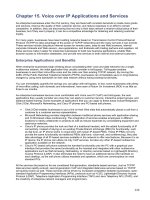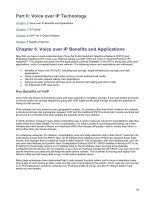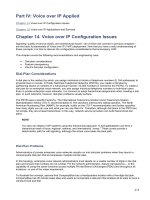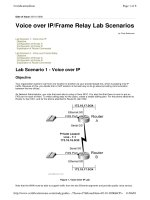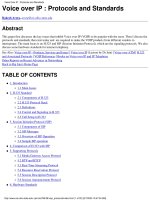Voice over IP Applications and Services
Bạn đang xem bản rút gọn của tài liệu. Xem và tải ngay bản đầy đủ của tài liệu tại đây (338.68 KB, 20 trang )
Chapter 15. Voice over IP Applications and Services
As enterprise businesses enter the 21st century, they are faced with constant demands to create more goods
and services, improve the quality of their customer service, and reduce expenses in an effort to remain
competitive. In addition, they are discovering that not only is their data network a mission-critical piece of their
business, but if they use it properly, it can be a competitive advantage for obtaining and retaining customer
loyalty.
For many years, businesses have been building networks based on Transmission Control Protocol/Internet
Protocol (TCP/IP) to take advantage of the power of TCP/IP networking and the many services it can provide.
These services include ubiquitous Internet access for remote users, easy-to-use Web browsers, internal
corporate Intranets and Web servers, Java applications, and Extranets with trading partners and suppliers. All
these services make it easier for enterprise businesses to build new business applications, enable Web-
browser access to information databases, and provide new services to both internal and external customers.
Enterprise Applications and Benefits
When enterprise businesses begin thinking about consolidating their voice and data networks into a single
multiservice network, the initial application they usually consider is toll-bypass. Toll-bypass enables
businesses to send their intra-office voice and fax calls over their existing TCP/IP network. By moving this
traffic off the Public Switched Telephone Network (PSTN), businesses can immediately save on long-distance
charges by using extra bandwidth on their data network without losing existing functionality.
You can immediately quantify the savings you can glean with toll-bypass. In fact, some businesses with plenty
of intra-office calling, both domestic and international, have seen a Return On Investment (ROI) in as little as
three to six months.
As enterprise businesses become more comfortable with Voice over IP (VoIP) and toll-bypass, the next
applications they usually consider are ones they can apply to customer service, interactive project groups, and
distance-based training. Some examples of applications that you can apply to these areas include Netspeak's
Click-2-Dial, Microsoft's Netmeeting, and Cisco IP phones and PC-based soft phones.
• Click-2-Dial enables businesses to put a link on their Web sites that automatically places a call from a
customer to a customer service representative.
• Microsoft Netmeeting provides integration between traditional phone services with application-sharing
and H.323-based video-conferencing. This integration of services enables employees in different
locations to easily collaborate on projects as well as reduce expenses by consolidating equipment and
data/voice networks.
• Cisco's IP phone provides the look and feel of a traditional handset, with the added functionality of IP
connectivity. Instead of relying on an existing Private Branch eXchange (PBX) for functionality, such
as dial tone, an IP phone works in conjunction with newer IP-based PBXs. These IP-PBXs not only
provide the same functionality as traditional PBXs (dial tone, voice-mail, and conferencing), they also
take advantage of all IP-based services available in the network to offer new features. Because it is an
IP device, the IP phone can utilize not only VoIP services, but also any other IP-based multiservice
application available on the network.
• Cisco's PC-based soft phone extends the handset functionality onto the PC with a graphical user
interface that provides the same functionality as the handset and integrates with other multiservice
applications such as Web browsing, Netmeeting, or directory services based on Lightweight Directory
Access Protocol (LDAP). It also eliminates the need to have an additional device (the handset) on
each desktop, as the soft phone utilizes headsets and speakers, which are commonplace on most
standard PCs.
All the services discussed so far are considered first-generation, standards-based services. Just as TCP/IP
data services rapidly evolved, second-generation VoIP and integrated data/voice services based on TCP/IP
will quickly evolve as well. These services will be driven by increased competition between businesses, open-
standard Application Programming Interfaces (APIs), protocols such as H.323, Lightweight Directory Access
Protocol (LDAP), Telephone Application Programming Interface (TAPI) and Java Telephony API (JTAPI), and
the creativity of enterprise network managers and programmers.
220
Enterprise VoIP Case Study: B.A.N.C. Financing International
The following case study describes ways a fictional international financial institution can use VoIP to initially
reduce expenses and eventually offer new internal and external services that provide greater flexibility to both
its employees and customers.
The Background and Setup of B.A.N.C.
B.A.N.C. Financing International is a multinational financial institution headquarted on the East Coast of the
United States. It provides mortgage lending, brokerage accounts, and other financial services, and it has
offices throughout the United States, as well as in Europe and Asia.
Like many businesses within the financial industry, it is quickly moving into new markets through expansion
and mergers with other financial institutions. It recently acquired two small banks in the United States and
plans to add three or four financial services groups in Europe and Asia within the next 18 to 24 months.
B.A.N.C. currently provides loan and mortgage rate details to customers through its Web page, but it wants to
offer additional services through the Web. It also wants to reduce its customer service costs.
B.A.N.C.'s existing data network comprises about 50 percent TCP/IP, 35 percent Systems Network
Architecture (SNA), and 15 percent Internetwork Packet Exchange (IPX) traffic. Its data infrastructure is made
up of Cisco routers and switches, and it is actively working to enable quality of service (QoS) on its campus
local-area network (LAN) and wide-area network (WAN) backbone in anticipation of future multimedia
applications. As it acquires new companies, it standardizes on Cisco routers and switches and removes any
protocols other than IP, IPX, and SNA.
In the future, B.A.N.C. hopes to transition its IPX servers to TCP/IP so that it can consolidate on two protocols.
The majority of its traffic consists of intraoffice communications between loan officers and the IP or SNA
databases at headquarters. Its WAN is made up of an international Frame Relay backbone; most sites have
256 Kbps circuits with 128 Kbps committed information rate (CIR).
B.A.N.C.'s voice network was initially made up of a single PBX vendor with remote key-systems, but with its
recent acquisitions it also acquired PBX technology from other vendors. Although it can still provide telephony
services, B.A.N.C. cannot provide feature transparency between the different PBX vendors. All its remote sites
use leased lines to interconnect the branch offices with the headquarters PBX and voice-mail system. Some of
these remote connections are full T1 lines, and others are fractional T1 lines. A representative diagram of
B.A.N.C.'s existing network is shown in Figure 15-1
.
221
Figure 15-1. Existing B.A.N.C. Data/Voice Network
B.A.N.C.'s Plan of Expansion
As B.A.N.C. began to investigate ways to meet its goals of greater customer service and reduced costs, senior
management challenged the Information Technology (IT) group to drive initiatives toward those goals. It
wanted IT to provide systems that could not only meet the goals, but also provide the flexibility to handle 21st-
century challenges.
As the IT group began to analyze the cost of maintaining both its voice and data networks, it realized that more
than 50 percent of all IT expenses were associated with long-distance voice and fax calls between its remote
and headquarters offices. In particular, international calls made up 65 percent of those long-distance charges.
In addition to these charges, B.A.N.C. also determined that the expense of providing office space for the
customer service group in the headquarters buildings was growing at a rate greater than the return on that
portion of the business.
As its first initiative, it sought ways to reduce these two expenses while maintaining the existing services these
functions provided.
When the B.A.N.C. IT group also began to analyze its data network, it further determined that on average its
WAN was about 60 to 70 percent utilized during peak hours of the day. This means that on most of its 128
Kbps circuits, it was using only 77 to 90 Kbps.
Consolidating the Networks
After it collected this information, B.A.N.C. sought to find a way to consolidate its networks in an effort to
reduce costs and maintain functionality. B.A.N.C. laid out the following guidelines for its discussions with
multiservice network vendors:
• It wanted to work with one of its existing PBX or networking vendors to provide an end-to-end solution,
if possible.
• It wanted to provide 21st-century technology to its internal and external customers, but it didn't want to
be on the bleeding edge in terms of technology risk.
• It wanted to avoid forklift-upgrades to its existing infrastructure. A forklift-upgrade occurs when most or
all of a company's existing network hardware and software needs to be replaced with newer hardware
222
and software. This is not only expensive in terms of capital expenditure, but it also involves physical
visits to each site and disruptions of the existing network functionality.
• It wanted its new multiservice network to be Internet-capable so that it could interact with new
technologies in the future.
• It didn't want to have to retrain its employees to use the new multiservice network, nor did it want to
eliminate the expertise it had in its existing IT groups for both voice and data.
• It wanted the new multiservice network to be cost-effective and expense-reducing.
After B.A.N.C. defined its objectives, it began discussions with its incumbent data and PBX vendors. As the
discussions progressed and the vendors explained their existing solutions and future visions of multiservice
networking, it became clear to B.A.N.C. that its data applications (both traditional and Web-based) were
growing faster than its voice-related interactions with customers.
It also realized that its competitors, in fields such as online banking and brokerage services, were quickly
surpassing B.A.N.C. because of their capability to offer new services at reduced costs using Internet-based
technologies.
As the B.A.N.C. IT group evaluated the vendors' proposals, it determined that Cisco Systems' current
multiservice offerings could provide an end-to-end solution that would meet all its stated needs. In addition to
B.A.N.C.'s immediate needs, the Cisco Systems solution provided the capability to integrated B.A.N.C.'s voice
and data network with future Web-based TCP/IP applications.
The highlights of the Cisco Systems solution include the following:
• Leveraged B.A.N.C.'s existing data network, which was made up of 2600 and 3600 series routers.
Both the 2600 and 3600 series are modular routers/VoIP gateways. They provide more than 60 LAN
and WAN interfaces, from async to optical carrier 3 (OC-3) ATM, as well as analog and digital voice
interfaces such as T1/E1, Foreign Exchange Station (FXS), FXO, and recEive and transMit (E&M).
Both routers share the same network modules, so stocking, sparing, and consistency across the family
of products is maintained. The 2600 series offers up to two LAN interfaces and up to four WAN
interfaces, plus the capability to add up to four analog or two digital voice interfaces. The 3600 series
includes the 3620, 3640, and 3660. These routers can have up to 14 LAN interfaces, up to 96 WAN
interfaces, up to 24 analog voice interfaces, or up to 12 digital voice interfaces.
• Based on open-standard, H.323 protocols.
• Provided an integration path that utilized B.A.N.C.'s existing data network and PBX equipment.
• Required neither extensive reconfiguration of existing data and voice equipment, nor a forklift-upgrade
of any equipment.
• Enabled the B.A.N.C. IT group to continue utilizing the expertise of both its voice and data support
staff.
Interoperated with other multiservice technologies that Cisco Systems offers, including Cisco IP
phones and IP PBXs, as well as H.323-based applications, such as Click-2-Dial and Netmeeting.
•
A representation of the proposed Cisco Systems solution is shown in Figure 15-2.
223
Figure 15-2. Proposed Multiservice Network
Highlights of the proposed solution include:
• Continued use of the 2600, 3620, and 3660 series routers that B.A.N.C. was using for its data
networks. B.A.N.C. also can add analog and digital voice network modules where appropriate to its
existing empty module slots.
• Immediate cost savings by moving B.A.N.C.'s intraoffice voice and fax calls onto its TCP/IP data
network. B.A.N.C. eliminated the leased lines as well as reduced its long-distance charges associated
with those calls.
• Future capability to replace small-office key-systems with Cisco IP phones and to reduce lease costs
when the key-system leases expired.
• Capability to integrate both Cisco IP phones and existing voice equipment with multiservice
applications such as Netmeeting or Intel ProShare video-conferencing using H.323.
In addition to moving intraoffice voice and fax calls onto its data network, the B.A.N.C. IT group also realized
that, with the flexibility of VoIP, it could offer its customer service representatives the option of working from
home without losing any functionality.
Using a Cisco Systems small office, home office (SOHO) router such as the 1750, B.A.N.C. could offer low-
cost Integrated Services Digital Network (ISDN) dial-up access at an annual cost that was a fraction of the
office-space charges it was currently paying.
Chicago Router Overview
The router configurations for the B.A.N.C. project are as follows (only relevant portions of the configuration
files are shown):
hostname Chicago
!
voice-card 1
codec complexity high
* This command defines which codecs can be used with the Voice Network Module.
High Complexity allows G.711, G.726, G.728, G.729, G.723.1 and Fax-Relay
!
ipx routing
!
dlsw local-peer peer-id 192.168.101.1 promiscuous
224
!
controller T1 1/0
description "1-8:Denver, 9-10:Tokyo"
framing esf/
linecoding b8zs
clock source line
ds0-group 1 timeslots 1-8 type e&m-wink-start
ds0-group 2 timeslots 9 type fxo-loop-start
ds0-group 3 timeslots 10 type fxo-loop-start
* These commands define the clocking, framing, linecoding and signaling for each
DS0
within the T1 controller card.
!
voice-port 1/0:1
* A Voice-Port is created for each ds0-group that is created above.
!
voice-port 1/0:2
connection trunk 998
* Connection trunk creates a permanent VoIP call between 2 VoIP gateways. It
allows
features such as hookflash or stuttuer dialtone to be passed over the IP network
to
the connected telephony devices. The digits with connection trunk as dialed
"internally" by the router and are not seen by the user. The digits are matched
against a VoIP dial-peer to complete the call.
!
session target ipv4:192.168.103.2
!
voice-port 1/0:3
connection trunk 999
!
dial-peer voice 1 voip
description "trunk/opx connections to Tokyo"
destination-pattern 99.
session target ipv4:192.168.102.2
!
dial-peer voice 2 voip
description "calls to Denver office"
destination-pattern 5….
!
dial-peer voice 3 voip
description "calls to IP Phones..CallMgr."
codec g723r63
destination-pattern 4….
session target ipv4:192.168.101.100
!
dial-peer voice 4 pots
destination-pattern 6….
prefix 6
port 1/0:1
dial-peer voice 5 pots
destination-pattern 6….
prefix 6
port 1/0:2
!
dial-peer voice 6 pots
destination-pattern 6….
prefix 6
port 1/0:3
interface FastEthernet 1/0/0
ip address 192.168.100.1 255.255.255.0
ipx network 100
!
interface FastEthernet 1/0/1
225
ip address 192.168.101.1 255.255.255.0
ipx network 101
!
interface serial 2/0/0
encapsulation frame-relay
frame-relay traffic-shaping
!
interface serial 2/0/0.1
ip address 192.168.102.1 255.255.255.0
ipx network 102
frame-relay interface-dlci 102
frame-relay class voip_qos_128k
*This command maps the frame-relay traffic-shaping, FRF.12 and QoS features to
this
PVC.
!
interface serial 2/0/0.2
ip address 192.168.103.1 255.255.255.0
frame-relay interface-dlci 103
frame-relay class voip_qos_128k
ipx network 103
!
interface serial 2/0/0.3
ip address 192.168.104.1 255.255.255.0
frame-relay interface-dlci 104
frame-relay class voip_qos_256k
ipx network 104
!
map-class frame-relay voip_qos_128k
no frame-relay adaptive-shaping becn
frame-relay ip rtp priority 16384 16383 48
frame-relay cir 128000
frame-relay bc 560
frame-relay fragment 160
frame-relay fair-queue
frame-relay ip rtp header compression
* These commands define the rules for Frame-Relay Traffic-Shaping, FRF.12
fragment
size and VoIP QoS using IP RTP Priority.
!
map-class frame-relay voip_qos_256k
no frame-relay adaptive-shaping becn
frame-relay ip rtp priority 16384 16383 48
frame-relay cir 256000
frame-relay bc 560
frame-relay fragment 320
frame-relay fair-queue
frame-relay ip rtp header compression
!
router rip
network 192.168.100.0
network 192.168.101.0
network 192.168.102.0
network 192.168.103.0
network 192.168.104.0
226
B.A.N.C has a five-digit dialing plan so that any employee can call another office by dialing five digits. The
numbering is as follows:
Chicago Office: 6xxxx
IP Phones: 4xxxx
Denver: 5xxxx
Tokyo: Uses 6xxxx Off-Premise Extensions from the PBX
The 3660 router in B.A.N.C.'s Chicago office has VoIP dial-peers that point to all the company's remote offices.
The Tokyo office is a special case because it has hookflash functionality, which makes it appear to the PBX as
though it is a directly connected station. Hookflash is a method of providing additional services, such as call
waiting or conferencing between the PBX and the handset. Hookflash is activated when a user briefly presses
the cradle button on his or her phone. Hookflash sends a momentary on-hook/off-hook signal to the PBX,
notifying the PBX that the user is requesting additional services.
Hookflash requires a permanent VoIP call between two gateways. A connection trunk provides this capability.
A permanent call is created when the IP connectivity between two gateways is established. This differs from a
switched call, which is established when a user needs to place a call. Also, a permanent call provides the
capability to emulate a "wire" between the two devices so that they appear to be directly connected, and it
enables the passing of certain signaling such as hookflash or stutter dial tone. This is often useful when users
want to maintain their dial plan on their connected PBXs, or when they want to maintain "directly connected to
PBX" functionality for remote stations.
Each Chicago Frame Relay permanent virtual switch (PVC) is traffic-shaped to enable only data and voice
traffic up to the guaranteed CIR. This is done to prevent packets from being dropped or excessively delayed
(queued in the Frame Relay switch). Each PVC uses Frame Relay Forum 12 (FRF.12) to fragment the data
packets at Layer 2, thereby preventing serialization delay. The PVCs also use IP RTP Priority to identify the
VoIP packets and to give them highest priority for outbound queuing.
The 3660 in the Tokyo office is configured to use a connection trunk which provides a permanent VoIP call that
can pass hookflash calls as well as keep the dial plan on the PBX for digital signal level 0 (DS-0) calls. The
3660 in this office also has a VoIP dial-peer that points to the IP address of the Cisco Call Manager for Cisco
IP phones.
Cisco Call Manager is an IP-PBX system. It provides all PBX functionality to IP phones through Call Manager
software that runs on a Windows NT server. All communication between CCM, the IP phones, and VoIP
gateways is done through IP.
You also can integrate Cisco Call Manager with legacy PBXs or key-systems using VoIP gateways.
Cisco Call Manager can support only G.711 or G.723.1 codecs. In this case, G.723.1 is configured to conserve
bandwidth, and all the other connections are made with the G.729 codec. The Frame Relay PVCs are traffic-
shaped so that data or voice cannot burst above CIR. This guarantees that the voice packets are not dropped
within the Frame Relay cloud or queued so that delay and jitter are created within the cloud. Also, the VoIP
traffic is defined to receive the highest QoS on the WAN links.
London Router Overview
The London router configuration is as follows:
hostname London
!
ipx routing
!
dlsw local-peer peer-id 192.168.105.1
dlsw remote-peer 0 tcp 192.168.101.1
227
